Ada Pradhaman is a traditional dessert from the South Indian state of Kerala, prominently featured during Onam, the harvest festival, and other celebratory occasions. Its roots lie deep within the Malayali culture, embodying the essence of Keralite festivities.
The dish is essentially a type of payasam or kheer, which are terms used across India to describe sweet, milk-based puddings. What sets Ada Pradhaman apart is its use of ada – rice flakes made from a batter spread thinly and dried, then cut into small pieces, as the core ingredient. This distinctive element provides a unique texture, which when combined with the flavors of the dish, creates a luxurious eating experience.
The preparation of Ada Pradhaman involves cooking the ada in a mixture of coconut milk and jaggery. Coconut milk is used in three different consistencies – thin, medium, and thick – added at various stages of the cooking process to achieve a rich flavor and consistency. Jaggery, unrefined sugar made from dates, sugarcane, or palm, imparts a deep, caramel-like sweetness contrasting beautifully with the creamy coconut milk. The dish is further enhanced with a generous sprinkling of cardamom, ghee-roasted cashews, raisins, and sometimes even a hint of ghee itself to add depth to its flavor profile.
Historically, the inclusion of ada in this dessert marks an evolution of culinary practices, likely influenced by the agricultural patterns and availability of ingredients in Kerala. Rice being a staple in South Indian diets, its versatility is showcased in both savory and sweet dishes, ada Pradhaman being a prime example of the latter.
Ada Pradhaman is not just a dessert; it’s a celebration of Kerala’s agricultural abundance, culinary ingenuity, and cultural heritage. It brings together communities, transcending social and economic boundaries during festivals, weddings, and other moments of collective joy.
Ada Pradhaman Recipe
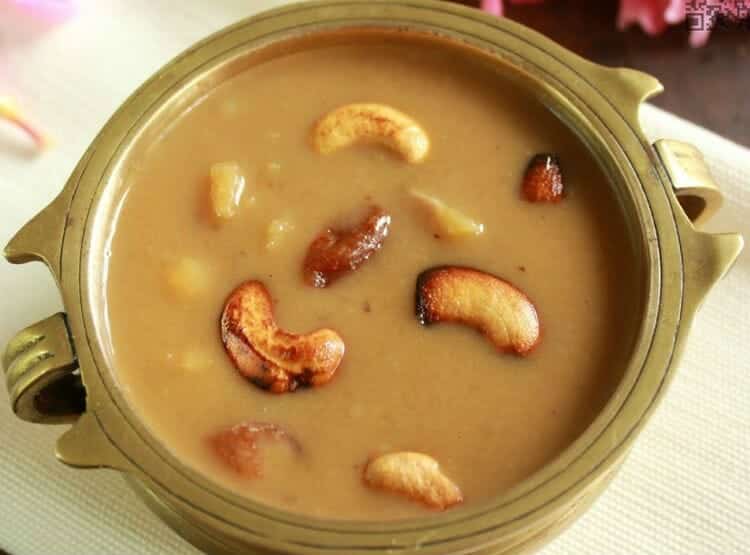
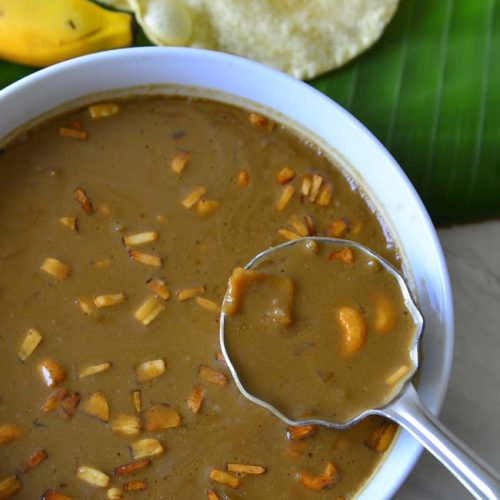
Ada Pradhaman
Equipment
- 1 medium saucepan
Ingredients
- 21/2 cups water divided
- 1/2 cup rice flakes
- 3/4 cup powdered jaggery
- 2 cups full-fat coconut milk
- 2 green cardamom pods crushed
Instructions
- In a medium saucepan over high heat, bring 2 cups of water to boil, then turn off the heat.
- Add the rice flakes, cover the pan, and let sit for 10 to 12 minutes. Drain the rice flakes in a fine-mesh strainer and rinse them under cold water. Transfer the rice flakes to a bowl and set aside.
- Wipe out the saucepan and return it to medium heat. In the pan, combine the remaining 1⁄2 cup of water and jaggery. Bring the mixture to a simmer. When the jaggery melts, turn off the
- heat. Strain the jaggery water through a fine-mesh strainer set over a bowl to remove any impurities.
- Return the saucepan to the heat and add the jaggery water, coconut milk, and cardamom. Simmer for 5 to 7 minutes.
- Stir in the rice flakes and simmer for 4 to 5 minutes. Turn off the heat. Serve warm.
Notes
Cooking Tips about Ada Pradhaman
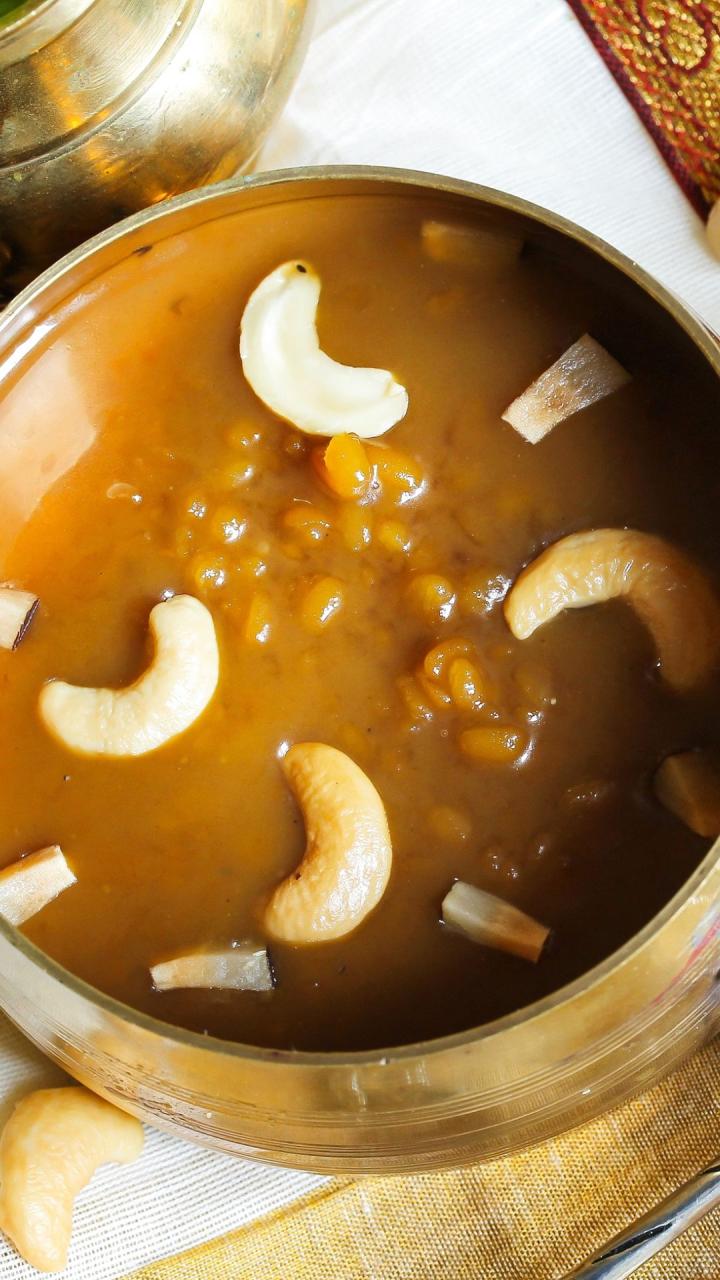
1. Selecting the Right Ada
- The Ada, or rice flakes, is the soul of this dish. Opt for good quality, precooked ada available in South Indian grocery stores or online. If you’re up for it, making homemade ada, though time-consuming, can significantly enhance the taste.
2. Preparing the Ada
- Before cooking, the ada needs to be properly rinsed and soaked in water to remove any starchiness and impurities. This also ensures they don’t stick together while cooking.
- Boil the ada until it becomes soft yet retains a slight bite, similar to cooking pasta ‘al dente’. This texture is crucial for the final mouthfeel of the dish.
3. Mastering Coconut Milk Consistency
- Use coconut milk in three different consistencies (thin, medium, thick) added at various stages. Start with the thinnest consistency to cook the ada, followed by the medium consistency for flavor, and finish with the thick milk for richness and creamy texture.
- If you’re using canned coconut milk, dilute it with water to get the varying consistencies.
4. Balancing Sweetness with Jaggery
- The choice of jaggery can significantly affect the flavor. Look for high-quality jaggery that’s dark and rich in taste for that classic, caramel-like sweetness.
- Melt the jaggery in a little water and strain to remove any impurities before adding it to the dish to ensure a smooth texture.
5. Enhancing Flavor with Spices and Nuts
- Cardamom is an essential spice in Ada Pradhaman. Crush the pods just before adding them to release their full aroma and flavor.
- Ghee-roasted cashews and raisins not only add crunch and sweetness but also a layer of richness. Be careful not to burn them during roasting.
6. Cooking Technique
- Cook on a low-to-medium flame once the jaggery and coconut milk are added to prevent curdling. Stir continuously ensuring that the mixture doesn’t stick to the bottom of the pan.
- The consistency of the payasam should be neither too thick nor too thin; it will thicken as it cools.
7. Serving and Storing
- Ada Pradhaman is served both warm and cold, so taste it at both temperatures to see which you prefer.
- It can be stored in the refrigerator and tastes even better the next day as the flavors meld together beautifully.
Serving suggestions about Ada Pradhaman
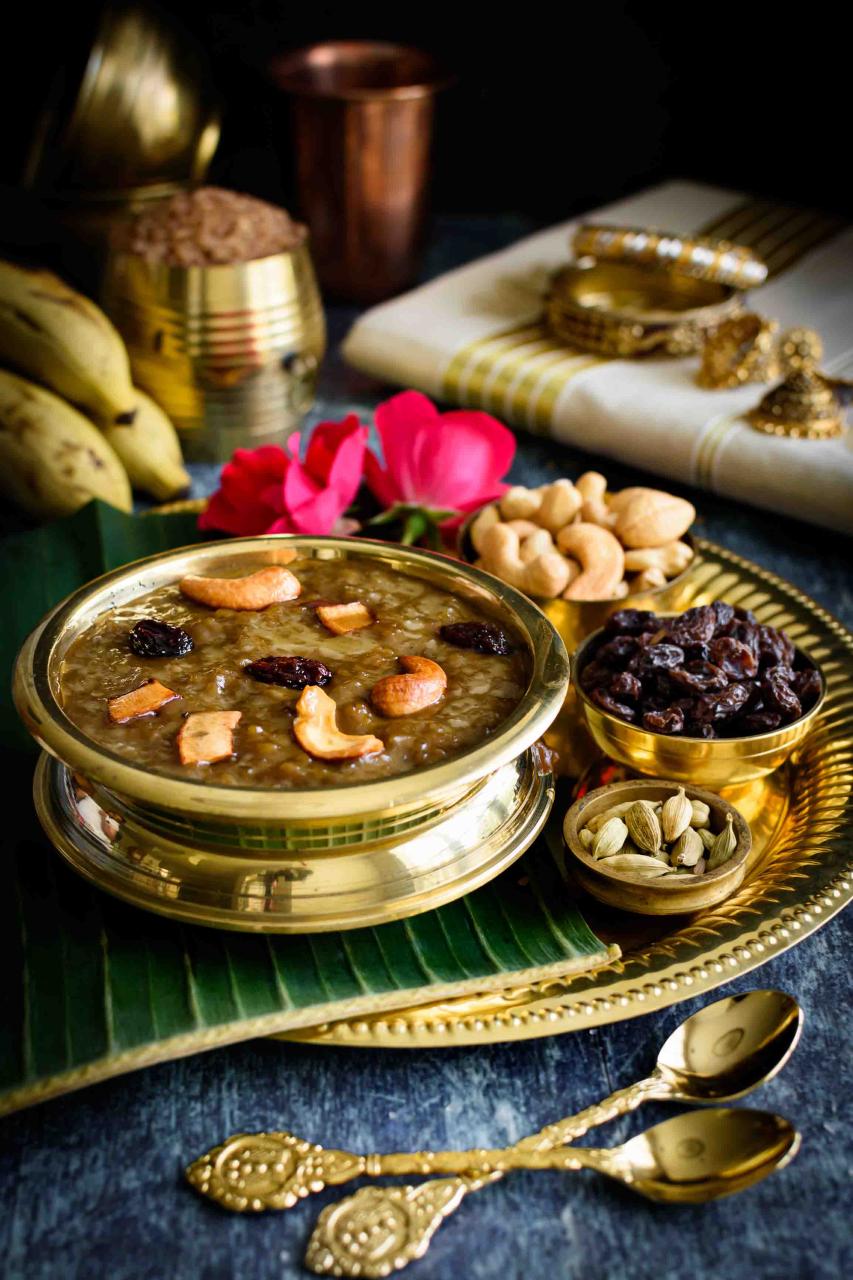
- Temperature Variation: Ada Pradhaman can be served either warm or cold. The warmth of the dish can bring out the rich aroma of spices and jaggery, offering a comforting experience, especially during cooler weather. On the other hand, serving it cold can be refreshingly sweet, perfect for hotter days or as a cool finish to a spicy meal.
- Garnishing: To add visual appeal and an extra layer of texture and flavor, consider garnishing the payasam with a sprinkle of freshly roasted cashews and raisins just before serving. A light drizzle of ghee over the top can also elevate the richness of the dish.
- Pairing with Meals: While Ada Pradhaman is a standout dessert on its own, it can also be paired with a light meal to balance its sweetness and richness. In a traditional Keralite feast or “sadya”, it is served towards the end, after the main courses. Pairing it with mildly spiced rice dishes or savories can provide a pleasant contrast.
- Serve in Traditional Utensils: For an authentic experience, serve Ada Pradhaman in traditional utensils like brass or clay pots. Serving it on banana leaves can also enhance the traditional feel and subtly infuse a natural fragrance that complements the dish’s flavors.
- Accompaniment by Simple Beverages: To cleanse the palate between servings or after finishing the dessert, a simple, light beverage such as a fragrant herbal tea or warm water with lemon can be offered. This helps in balancing the sweetness and richness of the dessert.
- Presentation: Presentation plays a big part in serving Ada Pradhaman, especially if it’s for a special occasion. Using decorative bowls or glassware can make each serving look more inviting. You could also consider layering the dessert with some coconut cream on top for a visually appealing and taste-enriched experience.
Top 5 FAQs about Ada Pradhaman
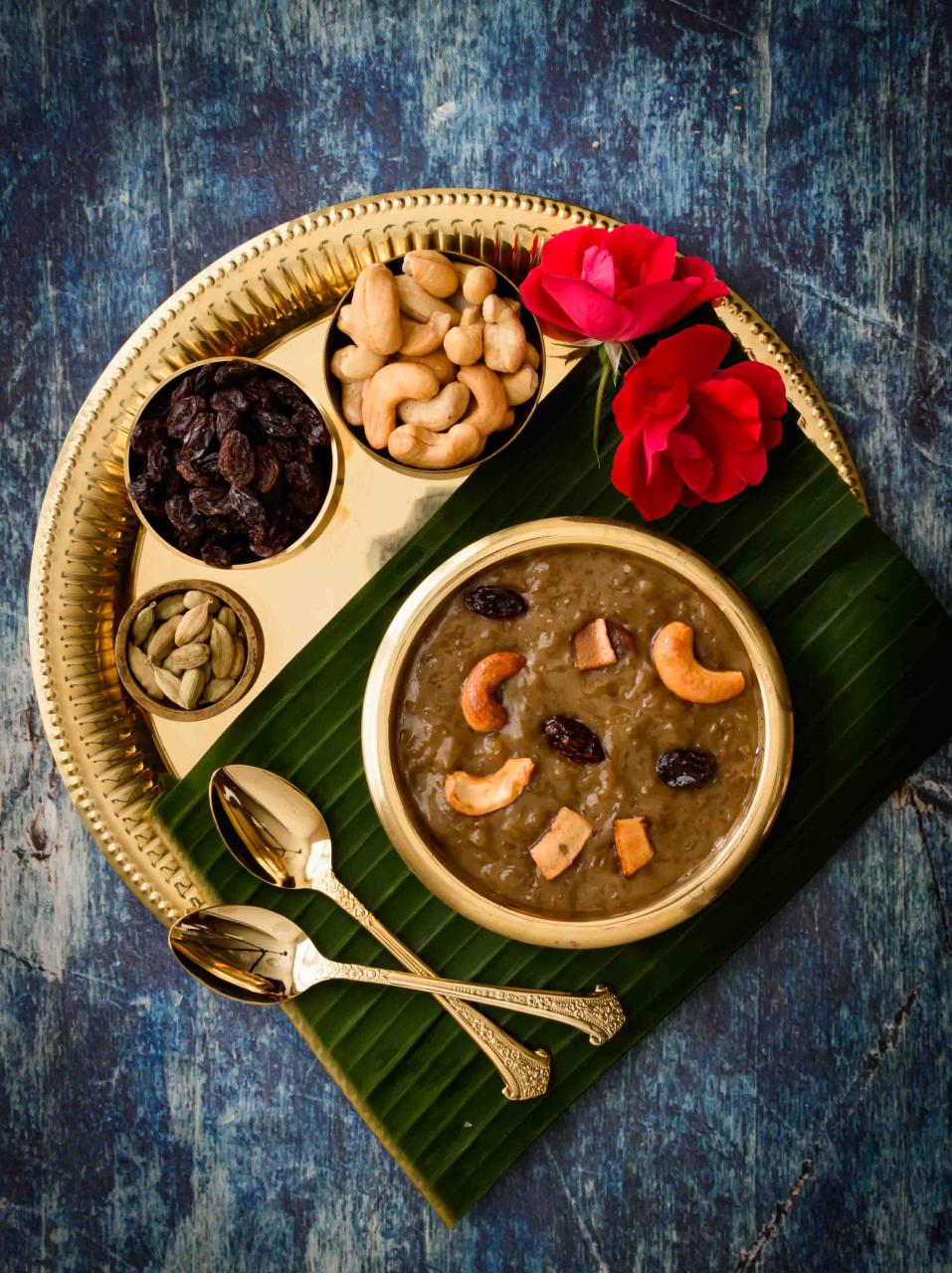
- What is Ada Pradhaman? Ada Pradhaman is a traditional South Indian dessert from Kerala, primarily served during the Onam festival and other celebratory occasions. It is a type of payasam made with ada (rice flakes), jaggery, coconut milk, and garnished with cardamom, ghee-roasted cashews, and raisins.
- How is Ada Pradhaman different from other types of payasam? The key differentiator of Ada Pradhaman is the use of ada or rice flakes, which provide a unique texture. Additionally, its preparation involves three different consistencies of coconut milk and jaggery, offering a rich flavor profile distinct from other payasams like those made with vermicelli or lentils.
- Where can I find ada for Ada Pradhaman? Ada can be found in South Indian grocery stores or online. For an authentic taste, opting for good quality, precooked ada is recommended, though making homemade ada is also an option for those looking to elevate the dish’s taste further.
- Can Ada Pradhaman be prepared in advance? Yes, Ada Pradhaman can be prepared in advance. It is often said that it tastes even better the next day as the flavors have more time to meld together. Just ensure to store it in the refrigerator if you’re planning to serve it later.
- Is there a vegan version of Ada Pradhaman? The traditional recipe already caters to a vegan diet as it uses coconut milk instead of cow’s milk and ghee. However, for strict vegans who avoid ghee, a plant-based oil or vegan butter can be used to roast the nuts and spices, making it completely vegan-friendly.
Ada Pradhaman stands as an exquisite testament to the rich culinary heritage of Kerala, India. This traditional dessert, integral to the state’s festive and celebratory occasions, notably Onam, is much more than just a sweet treat; it’s a cultural emblem that brings people together, embodying the essence of Keralite festivities. The dish’s unique use of ada (rice flakes), combined with the deep flavors of jaggery and coconut milk, enhanced with cardamom, ghee-roasted nuts, and raisins, creates a textural and flavor profile that is unparalleled among Indian sweets.

Leave a Reply